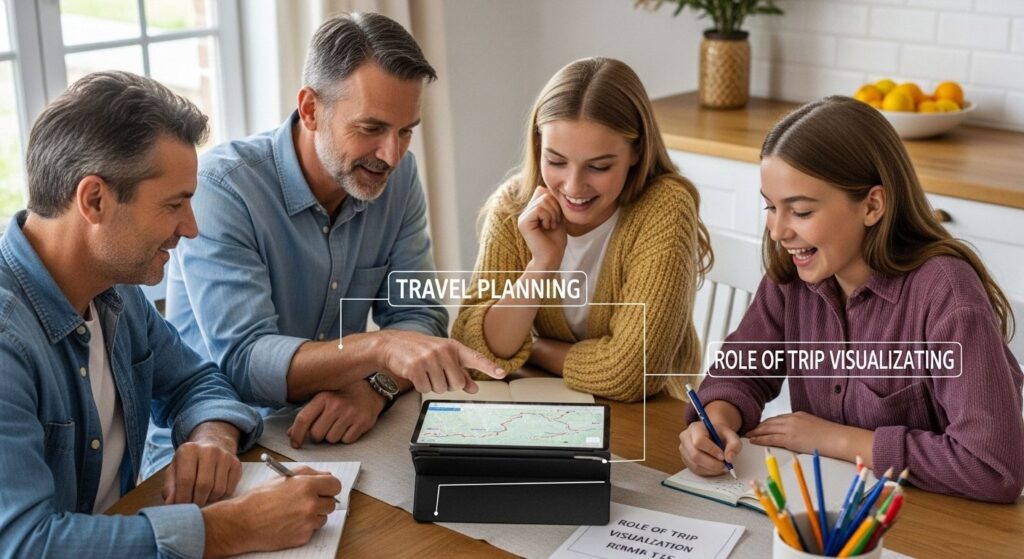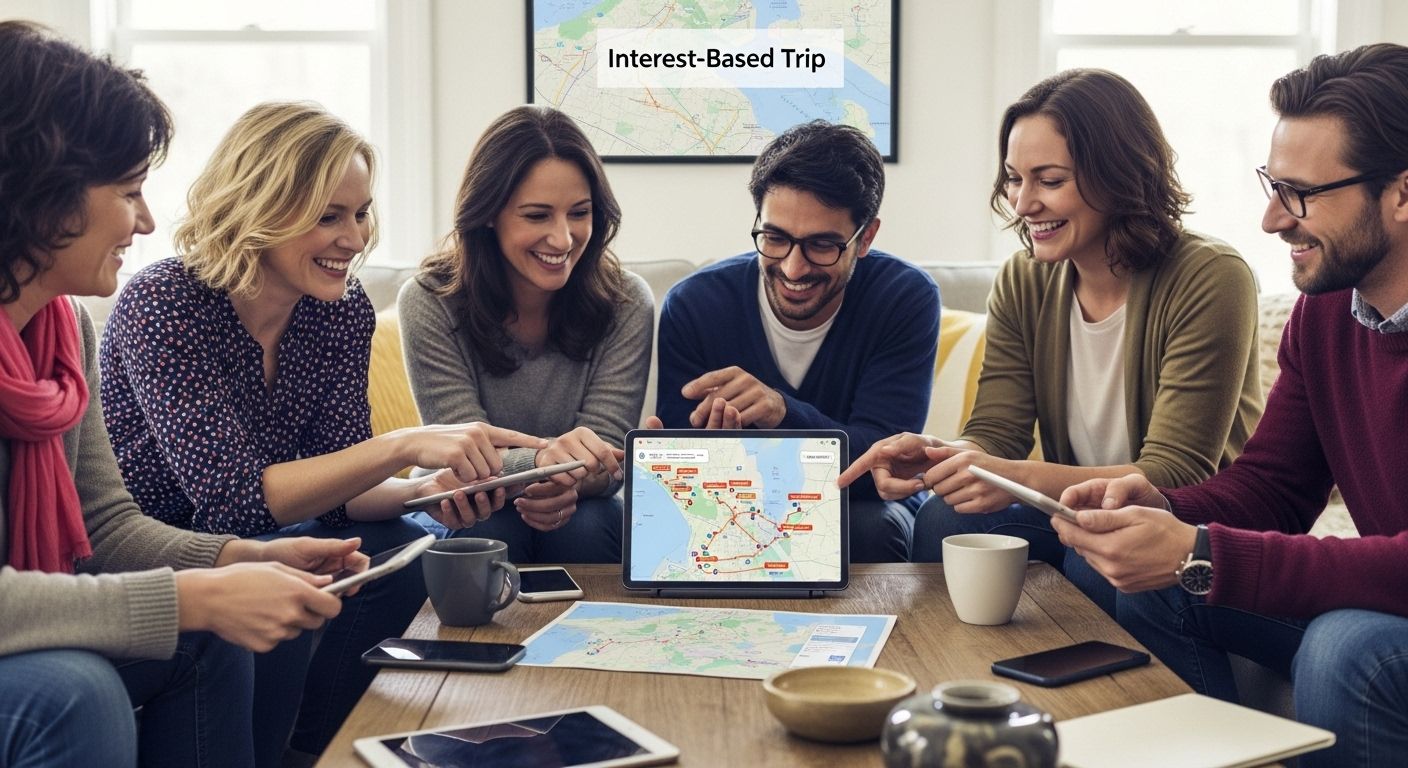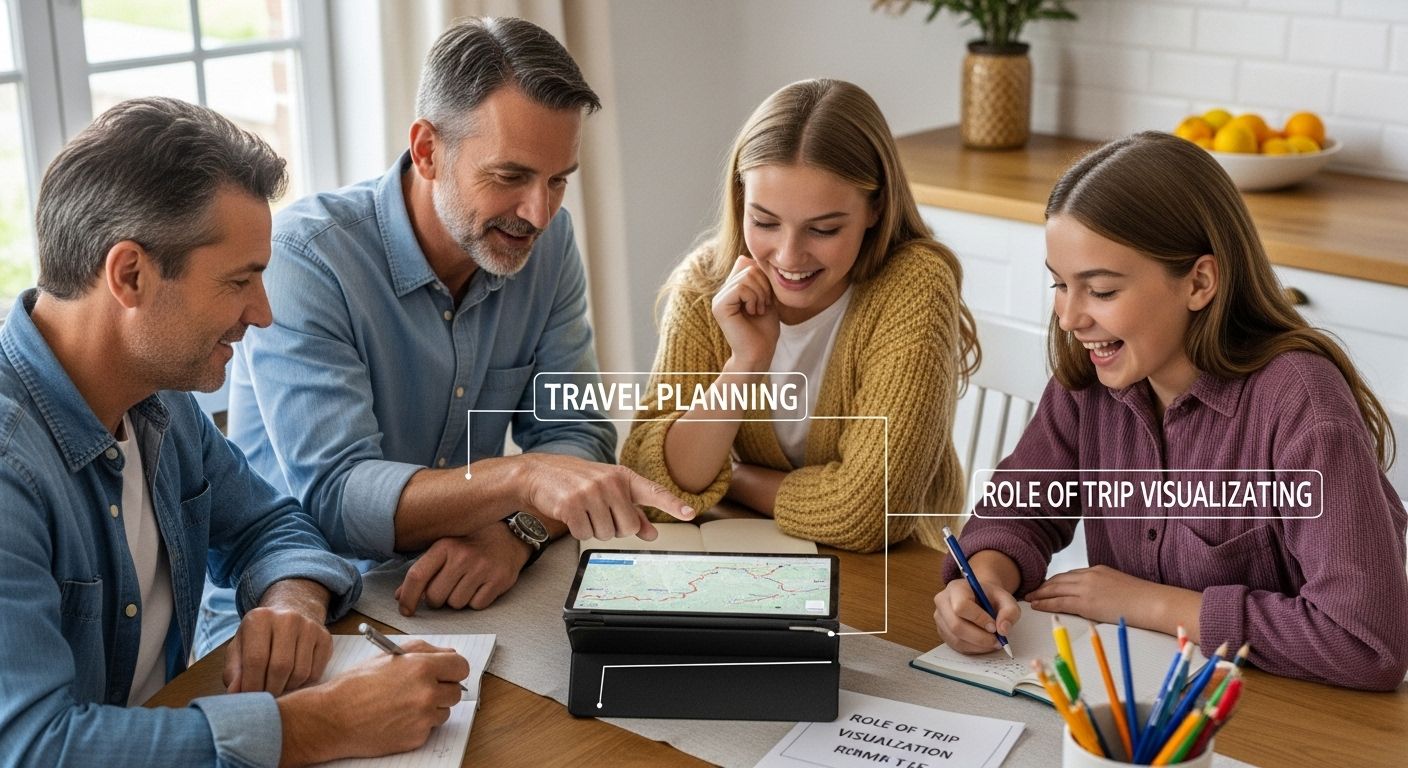Trip planning can feel overwhelming when you’re staring at a mountain of details and scattered notes. Yet check this out. Studies show that using visual planning tools can reduce planning stress by 50 percent and help travelers make decisions twice as fast. Most people still rely on spreadsheets or guesswork. The surprise is that trip visualization not only makes mapping out your journey easy but actually turns preparation into a personal, even exciting, adventure.
Table of Contents
- What Is Trip Visualization And Its Key Components?
- Why Trip Visualization Matters In Travel Planning
- How Trip Visualization Enhances Travel Experiences
- Theoretical Foundations Of Trip Visualization Techniques
- Real-World Applications Of Trip Visualization In Travel
Quick Summary
| Takeaway | Explanation |
|---|---|
| Trip visualization simplifies planning | It transforms complex travel logistics into clear, engaging visual formats, making decisions easier for travelers. |
| Interactive tools enhance decision making | Advanced platforms provide dynamic representations of routes and preferences, allowing for better strategic choices. |
| Personalized travel experiences are created | Visualization techniques allow customization, helping travelers align their journeys with personal preferences and budgets. |
| Reduce cognitive load during planning | Visual tools help manage overwhelming details, making the planning process more intuitive and manageable. |
| Anticipate challenges before departure | By visually mapping journeys, travelers can identify potential obstacles and prepare strategies to address them. |
What is Trip Visualization and Its Key Components?
Trip visualization transforms complex travel planning into an intuitive, strategic process that helps travelers understand and organize their journeys more effectively. At its core, trip visualization represents a powerful approach to converting abstract travel ideas into clear, manageable visual representations that guide decision making and enhance overall trip preparation.
Understanding the Visual Travel Planning Concept
Trip visualization goes beyond traditional planning methods by creating interactive, dynamic representations of travel routes, destinations, and experiences. Learn more about strategic trip organization helps travelers comprehend their journey’s entire landscape before setting foot outside their home. According to research from TriPlan, this approach integrates multiple information sources to provide comprehensive planning guidance.
The key components of trip visualization typically include:
To clarify the core elements discussed, the table below outlines the key components of trip visualization and their roles in the planning process.
| Component | Description |
|---|---|
| Geographic Mapping | Visual presentation of potential travel routes and locations |
| Time Allocation Visualization | Graphically representing time spent at various stops |
| Activity & Destination Clustering | Grouping activities and destinations for better organization |
| Interactive Journey Progression | Dynamic representation of trip steps and stages |
| Preferences & Constraints | Integration of personal interests and logistical limitations |
![]()
- Geographic mapping of potential routes
- Time allocation visualization
- Activity and destination clustering
- Interactive journey progression representation
Technical Foundations of Trip Visualization
At its technical foundation, trip visualization leverages advanced data representation techniques that transform raw travel information into meaningful visual narratives. This process involves synthesizing geographic data, time metrics, personal preferences, and logistical constraints into coherent graphical interfaces that travelers can easily understand and manipulate.
By converting complex travel logistics into intuitive visual formats, trip visualization enables travelers to:
- Quickly assess travel feasibility
- Optimize route efficiency
- Understand spatial and temporal relationships between destinations
- Make more informed planning decisions
The ultimate goal of trip visualization is to simplify the intricate process of travel planning, making it more accessible, enjoyable, and strategic for travelers of all experience levels.
Why Trip Visualization Matters in Travel Planning
Trip visualization has emerged as a critical tool in modern travel planning, transforming how travelers conceptualize, prepare, and execute their journeys. By converting complex travel information into intuitive visual formats, this approach addresses multiple challenges that traditional planning methods struggle to resolve.
Simplifying Complex Travel Logistics
Travel planning involves managing numerous interconnected variables that can quickly become overwhelming. Learn more about effective travel organization reveals how visualization techniques help travelers navigate these complexities. According to research from the National Renewable Energy Laboratory, making travel information explicit through visual presentations can significantly influence travelers’ decision making processes.
The primary reasons trip visualization matters include:
- Reducing cognitive load during planning
- Providing comprehensive journey perspectives
- Enabling faster strategic decision making
- Facilitating better resource allocation
Enhancing Decision Making and Travel Experience
Visualization goes beyond mere route mapping. It creates a holistic understanding of travel dynamics by integrating multiple information layers such as geographic constraints, time management, budget considerations, and personal preferences. This comprehensive approach allows travelers to:
- Anticipate potential challenges
- Optimize travel routes
- Balance time and resource constraints
- Create more personalized travel experiences
By transforming abstract travel concepts into tangible visual representations, trip visualization empowers travelers to make more informed, confident decisions. It turns complex planning into an engaging, strategic process that reduces stress and increases overall travel satisfaction.
How Trip Visualization Enhances Travel Experiences
Trip visualization transcends traditional planning techniques by transforming travel preparation into an immersive, engaging process that directly improves travelers’ overall experience. By converting abstract travel concepts into interactive, meaningful visual representations, this approach fundamentally reimagines how individuals interact with and anticipate their journeys.
Creating Personalized Travel Narratives
Explore personalized travel strategies reveals how visualization turns generic travel plans into tailored experiences. According to research from TriPlan, integrating user generated content with geographic information creates more meaningful travel representations that resonate with individual preferences.
Trip visualization enhances experiences by:
- Providing emotional connection to upcoming travel
- Reducing uncertainty and anxiety
- Allowing predictive exploration of destinations
- Enabling more intentional travel decision making
Psychological and Practical Benefits of Visual Planning
Visual planning goes beyond logistical organization. It taps into fundamental human cognitive processes, transforming travel from a series of logistical challenges into an anticipated adventure. By presenting travel information through intuitive visual interfaces, travelers can:
- Mentally rehearse their journey
- Understand spatial relationships between destinations
- Identify potential challenges before departure
- Develop a sense of excitement and preparedness
The ultimate power of trip visualization lies in its ability to convert complex travel data into compelling, personally meaningful narratives that inspire confidence and enthusiasm. It bridges the gap between abstract planning and lived experience, making travel preparation an enjoyable and empowering process.
The comparison table below summarizes how trip visualization supports both psychological and practical aspects of travel planning, as highlighted in the article.
| Benefit Type | How Trip Visualization Helps |
|---|---|
| Psychological | Enables mental rehearsal and reduces anxiety before the journey |
| Psychological | Creates an emotional connection and anticipation for the trip |
| Practical | Identifies potential challenges before departure |
| Practical | Clarifies spatial relationships between destinations |
| Practical | Supports more intentional, well-informed decision making |

Theoretical Foundations of Trip Visualization Techniques
Trip visualization techniques represent a sophisticated intersection of cognitive science, information design, and spatial reasoning, grounded in complex theoretical frameworks that explain how humans process and interpret visual information. These techniques transform abstract travel data into comprehensible, actionable representations that align with human cognitive capabilities.
Cognitive Processing and Visual Information
Discover advanced travel planning strategies illuminates the intricate relationship between visual perception and travel planning. According to research on visualization cognitive processes, visualization techniques follow a three stage theoretical model:
- Internalization of visual travel models
- Conceptualization of spatial and temporal relationships
- Externalization of travel planning insights
This framework demonstrates how visual representations help travelers translate complex information into meaningful travel experiences by engaging multiple cognitive processing channels simultaneously.
Principles of Information Design in Travel Visualization
The theoretical foundations of trip visualization draw from multiple interdisciplinary principles that prioritize human cognitive efficiency. By understanding how individuals perceive, interpret, and interact with visual information, researchers have developed design principles that make travel planning more intuitive and accessible.
Key theoretical principles include:
- Minimizing cognitive load through strategic information presentation
- Creating visual hierarchies that guide attention
- Developing intuitive spatial representations
- Enabling rapid pattern recognition
These principles transform trip visualization from a mere technical exercise into a sophisticated cognitive tool that bridges the gap between complex travel data and human decision making processes. The ultimate goal is to create visual representations that feel natural, informative, and empowering for travelers.
Real-World Applications of Trip Visualization in Travel
Trip visualization has transitioned from theoretical concept to practical tool, transforming how travelers plan, experience, and reflect on their journeys. Modern technological platforms are integrating sophisticated visualization techniques to provide unprecedented levels of travel planning and exploration support.
Innovative Travel Planning Platforms
Explore cutting-edge travel planning solutions highlights the evolving landscape of digital travel tools. According to research from the National Renewable Energy Laboratory, advanced platforms now offer comprehensive visualization capabilities that go beyond traditional mapping.
Real-world visualization applications include:
- Interactive route optimization systems
- Personalized mobility dashboards
- Dynamic travel preference tracking
- Predictive travel behavior modeling
Multi-Dimensional Travel Experience Design
Contemporary trip visualization techniques leverage complex data integration strategies to create immersive, personalized travel planning experiences. These approaches combine multiple information sources to generate comprehensive visual representations that adapt to individual traveler preferences and constraints.
Key practical applications encompass:
- Generating AI-powered travel recommendations
- Visualizing multi-modal transportation options
- Analyzing potential trip configurations
- Simulating travel scenarios before booking
By transforming abstract travel data into intuitive, interactive visual formats, these applications enable travelers to make more informed decisions, reduce planning anxiety, and create more meaningful travel experiences. The goal is not just to present information, but to facilitate a deeper, more engaging connection with travel planning and exploration.
Ready to Transform the Way You Visualize and Plan Your Trips?
If the complexity of travel logistics or the struggle to turn scattered ideas into a clear travel plan sounds familiar, you are not alone. As the article highlights, trip visualization is the key to reducing stress and gaining total clarity when organizing your journey. Imagine building your perfect itinerary with interactive maps, managing activities visually, and never losing track of your bookings.

Take the next step toward stress-free travel planning. Try Yopki today and experience how our all-in-one app lets you visually organize your day, shift plans with ease, and keep every detail in one place. Let us help you move from scattered notes to a smooth, optimized trip. Visit Yopki’s homepage now and bring your travel dreams to life.
Frequently Asked Questions
What is trip visualization in travel planning?
Trip visualization is a method that transforms complex travel plans into clear visual representations. It helps travelers organize and comprehend their journeys by combining geographic mapping, time allocation, and interactive elements.
How does trip visualization simplify travel logistics?
Trip visualization reduces cognitive load by presenting intricate travel information in understandable formats. This allows travelers to see the big picture, manage multiple variables, and make quicker strategic decisions.
What are the key components of trip visualization?
The key components of trip visualization include geographic mapping of routes, time allocation visualization, clustering of activities and destinations, and interactive representations of journey progression.
How does trip visualization enhance the travel experience?
Trip visualization enhances the travel experience by creating personalized travel narratives, enabling predictive exploration, reducing uncertainties, and allowing travelers to mentally rehearse their journeys, thereby increasing confidence and excitement.



